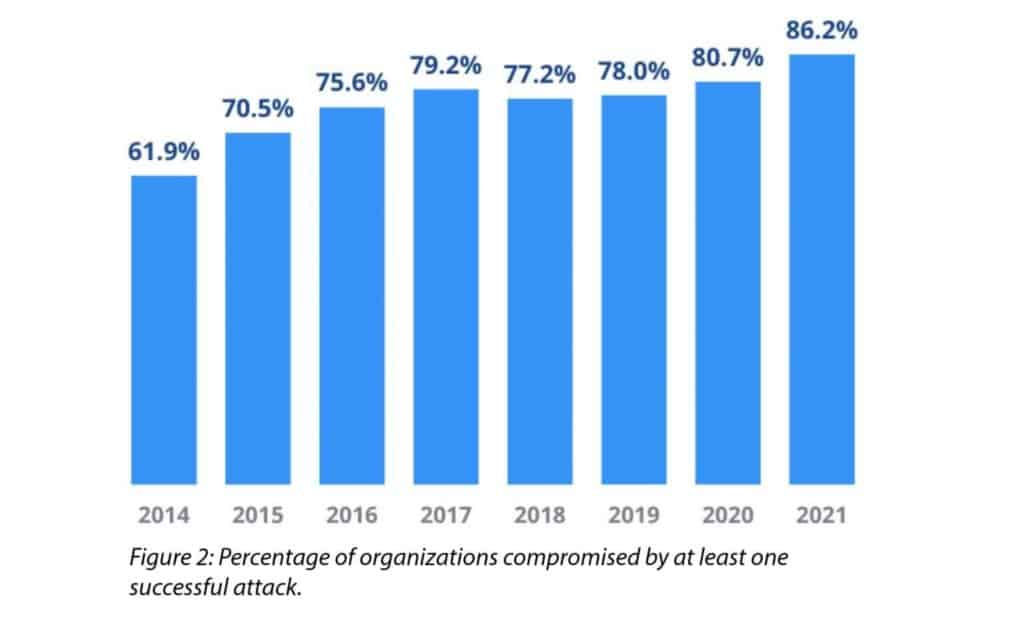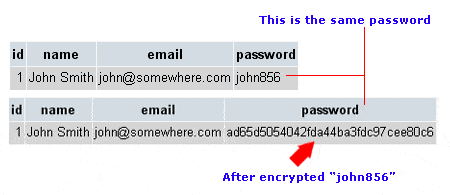Nothing is more important to a business than retaining a customer’s trust. They trust you with everything from their basic demographic information to their payment details. Hence, as a business, it is certainly not a given to take their trust for granted. Because let’s face it–customer data is crucial to any business. In a way, your business depends on that data.
With cybercrime on the rise and ample tools that allow collecting, monitoring and storing of data, maintaining customer data’s privacy isn’t just crucial but necessary.

As seen in the graph, the percentage of organizations that underwent at least one successful attack has kept on increasing each other. This calls for extreme care and security while collecting customer data. In this article, we will look at five such ways to preserve and protect customer’s data. However, before that, let’s understand ways of collecting customer data.
How can you collect customers’ information?
Securely collecting a customer’s data is still the second step. Security comes while collecting the data. So, before that, you should have an idea of ways to collect the data. You can gather customer data in two ways:
- Ask the customer directly
- Fetch data
In the first approach, you directly ask the customer for their information in the form of forms, polls, etc. In fact, you can create custom forms with simple drag and drop functionality. You should learn more about ways to efficiently and securely collect customer data with different tools available in the market. Such tools do not require coding which makes them easy to use and saves time.
While in the second approach, you analyze customer behaviour by keeping a tab on the transaction records, the number of clicks s/he makes on your website, etc. In both approaches, customer data is vulnerable. So without further ado, let’s understand how can you quickly and securely collect customer information so that you don’t risk a data breach and lose your customer base.
5 Best ways to collect customer data
For every business, enhancing customer experience is a continuous struggle. They want to give customers what they want. For that, collecting customer data is important. Through this data, businesses can predict customers’ preferences and personalize their experiences. You can use one or all of the below listed ways to ensure the security of your customer’s data.
Collect only the must-have information
Depending on the type of your business, you need to filter which customer information you compulsorily require and which data is optional. If you only ask for limited values from the customer, it will lead to two things:
- Increase customer’s faith in your business
- The customer is likely to fill in all details
If your input form has few fields, then the customer is more likely to fill it. While, if your form has hundreds of fields, chances are high you may lose the customer since they won’t take the time to fill all the fields.
However, this too depends on what type of service you provide. If you are a financial service provider then you may need more information. In this case, the customer will fill in all details since s/he is expecting some value out of it.
For example–you are an eCommerce store and you want a user to register themselves when they visit your page for the first time. Now, if your registration page has too many fields, the customer will lose interest and may choose not to fill all the fields.
A basic registration form should have a minimum of the following fields:
- First name
- Last name
- Address (State, country)
- Email id
- Contact number
If your business demands more fields, you can add them but make them optional. Remember– if it is extremely easy and less time consuming for a user to fill the details, s/he will likely turn into your customer.
Analyze Transaction Records
Analyzing transaction records is one of the best ways of knowing your customer. These records usually describe an event and always have time measurement and numeric values. Plus, this data includes more than one entity/person. Examples of transaction records could be orders placed, payments, invoices, etc.
These records also consist of customer conversations with sales staff either via phone calls or chats. These records give you quantitative data about customers and let you know them better.
While you can store transaction records of any customer, you must know which data should you store and which should you use only to verify. For example–you might need to store the customer’s first name and address to identify him/her. However, you might not need to store a customer’s credit or debit card details.
It is important to create a framework that lets third-party processors take care of such confidential data to go about it.
Take Surveys
A survey is one of the easiest and quickest form of gathering customer data. You can create surveys online within minutes today and share them via social media or emails. You can ask specific questions to the customer regarding your products and you can actually gauge your brand’s perception through their replies.
The good thing about surveys is–that you can include questions related to the customer’s identity and also your product. This way, you will know your customer better and have deeper insights into their preferences. You can also take polls on social media for the same.
If the customers find you authentic and genuinely care for your brand, they are likely to pass along their contact details your way. This way, you know your brand’s reputation, you know the customers and you can make changes in your services based on their feedback. These are safe since most of the questions in a survey are the free-text type. This reduces the chances of data breaches.
Limit data accessibility
Protecting the privacy of your customer’s data is essential for all businesses–big or small. However, if you are a small business, data breach can have far heavy repercussions than big businesses since your target audience is limited. You lose the risk of losing the customers entirely. You can avoid this with limiting the access of customer data to employees.
The more users/employees that have access to customer data, the more vulnerable points you leave for the hackers to easily steal data. You should know which customer data would be useful to which employee of your firm. Depending on this, you should give access to the data to a very limited number of employees.
You should only give access to the information that the employees require to perform some task or event on. This way, you ensure that the data is operated by only authorized entities. Also, limited access helps avoid internal data abuse.
For example–you want to fire an employee who has access to many tools consisting of customer data. Let’s say you took away access from five tools of six and missed out on the sixth one. There is a possibility of the employee misusing this data.
You should also use password management tools as frequent as possible to add another layer of security. You can set a strong password for each tool and save these passwords in a password management tool.

Use secure SaaS tools
In today’s day and age of data, covering the bare minimum security standards to protect customer data are not enough. Even though the cloud is a convenient platform to store data, it doesn’t come without its own security challenges. To address these challenges, you need to use tools specifically designed to keep customer data safe.
There are tools that can identify and protect against various cyber attacks like email phishing, DOS, etc. They also offer you backup options in case you end up losing the data. Some can collect and analyze data to find any threats and if found any, rank them as per their severity.
Hence, it is crucial to use SaaS tools that possess these security standards.
While using tools will help you lessen the threats, it is not enough always. You also need to regularly test your site to find any vulnerabilities that the tool might miss out on. You may need to hire a cybersecurity expert to do the task. If you do not work towards finding these weaknesses, someone can easily take advantage.
Conclusion
Well, this is all for the ways of collecting customers’ data quickly and securely.
Needless to say–your success is directly proportional to how well you know your customer. Also, there will always be a possibility of data being leaked. However, it is important to take measures in your control to keep your customer’s data safe and hence, the customer. So follow these ways to safely collect data and keep your customer entrusted to your brand.

Parita Pandya is an Engineer turned Writer. She usually finds herself writing for businesses. When she is not writing, she is either strumming her guitar or penning her thoughts down on paritapandya.com.









